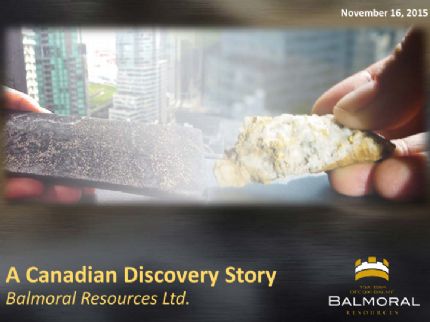 Intersects 10.50% Ni, 0.74% Cu, 1.87 g/t Pt and 4.87 g/t Pd Over 7.50 Metres in Deep Drilling of H3 Zone, Grasset, Quebec
Intersects 10.50% Ni, 0.74% Cu, 1.87 g/t Pt and 4.87 g/t Pd Over 7.50 Metres in Deep Drilling of H3 Zone, Grasset, Quebec
Vancouver, Nov 16, 2015 AEST (ABN Newswire) - Balmoral Resources Ltd. ( TSE:BAR) (
TSE:BAR) ( BALMF:OTCMKTS) today announced that the Company has intersected a very high-grade sulphide vein-breccia system in the immediate footwall to the H3 Nickel Zone, at the 425 metre vertical level, which returned 10.50% Ni, 0.74% Cu, 1.87% Pt and 4.87 g/t Pd over 7.50 metres. This interval, in hole GR-15-97 (see Table and Figures 1, 2 and 3 - in link below) when combined with the more typical, overlying, disseminated style H3 Zone mineralization produced a mineralized intercept of 63.02 metres grading 1.89% Ni, 0.15% Cu, 0.33 g/t Pt and 0.85 g/t Pd.
BALMF:OTCMKTS) today announced that the Company has intersected a very high-grade sulphide vein-breccia system in the immediate footwall to the H3 Nickel Zone, at the 425 metre vertical level, which returned 10.50% Ni, 0.74% Cu, 1.87% Pt and 4.87 g/t Pd over 7.50 metres. This interval, in hole GR-15-97 (see Table and Figures 1, 2 and 3 - in link below) when combined with the more typical, overlying, disseminated style H3 Zone mineralization produced a mineralized intercept of 63.02 metres grading 1.89% Ni, 0.15% Cu, 0.33 g/t Pt and 0.85 g/t Pd.
GR-15-97 intersected the H3 Zone approximately 50 metres down dip and 40 metres southwest of GR-15-87 (42.70 metres grading 1.11% Ni, 0.12% Cu, 0.20 g/t Pt and 0.49 g/t Pd - see NR15-12, Sept. 8, 2015) confirming the continuation of the high-grade core of the Zone to depth. Drilling also continued to expand the overall scale of the mineralized system with nickel bearing sulphides now intersected to a vertical depth of 540 metres along the projection of the H3 Zone.
The very high-grade vein-breccia intersected in hole GR-15-97 consists of a series of massive to semi-massive sulphide intervals cutting the ultramafic hosts at angles ranging from 10 to 85 degrees to core axis, consistent with a breccia-style of mineralization. The individual semi-massive to massive sulphide intervals display nickel grades ranging from 6.34 to 18.95% (the highest grade nickel assay returned to date from Grasset) and platinum + palladium grades of 4.63 to 13.66 g/t. Ni:PGE ratios are consistent with those observed throughout the H3 Zone. This separates this interval from the more typical high copper and PGE-rich footwall veins, suggesting it could mark a more primal or "feeder-type" zone. Additional drilling will be required to determine the extent and geometry of this new discovery.
"The discovery of this type of footwall vein-breccia system beneath H3 provides additional encouragement for further discoveries of very high-grade semi-massive to massive nickel sulphide bodies within the Grasset Ultramafic Complex" said Darin Wagner, President and CEO of Balmoral. "The timing of this discovery is excellent as work towards producing an initial resource estimate for the H3 Zone, which will incorporate the results released today, is underway. We expect these results early in 2016."
Drill hole GR-15-99a-w1 was collared in an attempt to test the central core of the H3 Zone to depth beneath hole GR-15-90a. The hole drifted at depth and ended up intersecting the plane of the H3 Zone approximately 55 metres to the SE of the intended pierce point. The hole did not intersect any significant nickel mineralization along the projected plane of the H3 Zone, possibly as a result of fault complications in this area.
GR-15-99a-w2, which was wedged off the pilot hole, intersected two broad, lower-grade nickel sulphide intervals, similar to those intersected in hole GR-15-80a above. These mineralized intervals appear to mark the vertical extension of the H3 Zone. The central plunge line of the Zone remains open and untested to depth beneath holes GR-15-97 and GR-15-90a (see Figure 2, in link below). Resource infill drilling within the shallower portion of the Zone aided in constraining the central fault corridor and returned a strong intercept of 30.04 metres grading 1.20% nickel in hole GR-15-93a at approximately 160 metres vertical depth (see Figure 4, in link below).
Gold Mineralization
Drill hole GR-15-95 returned a gold-rich intercept in the hanging wall to the H3 Zone. The 9.38 metre interval between 260.80 and 270.18 metres downhole returned an intercept grading 1.31 g/t gold, including 4.35 g/t gold over 1.48 metres between 260.80 and 262.28 metres. The Company currently recognizes three gold zones - two in the hanging wall and one in the footwall to the Grasset Ultramafic Complex - proximal to the H3 Zone.
Drilling is anticipated to resume at Grasset in January of 2016. Further expansion of the H1 and H3 Ni-Cu-PGE Zones, as well as a multi-hole program designed to follow-up on the Company's winter 2015 discoveries of Ni-Cu-PGE mineralization throughout the Grasset Ultramafic Complex will be the principal focus. In addition, the Company may undertake direct testing of one or more of the gold discoveries located proximal to the H3 discovery to determine if they provide a "value add" proposition to the evaluation of the H3 Zone.
Exploration Drilling - Grasset Gap and Hinge Areas
During the fall 2015 program the Company completed a total of nine exploration holes, six in the Grasset Gap VMS target area and three in the Grasset Hinge area. The Grasset Gap target area is located 14 to 21 kilometres east of the H3 Zone. The target is marked by a 7.0 kilometre long trend of stratiform airborne EM conductors which are now known to be associated with semi-massive to massive sulphide mineralization hosted by what are interpreted to be exhalative lithologies. Initial drill testing of five conductors intersected broad zones of massive to semi-massive sulphide mineralization, locally associated with anomalous levels of copper, lead, zinc and silver. Geologically the Grasset Gap Trend exhibits similarities to the productive West Camp in the nearby Mattagami VMS district. The Company will conduct follow-up testing of this new target area during 2016.
Widely spaced testing in the Grasset Hinge area, a strongly folded sequence dominated by mafic intrusive and extrusive rocks located NE of the H3 Zone, reinforced the Company's view that the Hinge is prospective for gold mineralization. All of the samples (163 in total) collected from two of the three holes in this area, GR-15-19 and GR-15-20, returned gold values above detection limits. Overburden cover in the Hinge area is considerably shallower than typically observed throughout the project making it potentially amenable to low-cost geochemical surveying to further refine targets.
To view the release including tables and figures, please visit:
http://media.abnnewswire.net/media/en/docs/81545-TSX_BAR_20151116.pdf
About Balmoral Resources Ltd
 Balmoral Resources Ltd. (
Balmoral Resources Ltd. ( TSE:BAR) (
TSE:BAR) ( OTCMKTS:BALMF) is a Canadian-based discovery company focused on high-grade nickel and gold discoveries on its wholly owned, 700+ square kilometre Detour Trend Project in Quebec, Canada. With a philosophy of creating value through the drill bit and a focus on proven productive precious/base metal belts, Balmoral is following an established formula with a goal of maximizing shareholder value through discovery and definition of high-grade, Canadian base metal and gold assets.
OTCMKTS:BALMF) is a Canadian-based discovery company focused on high-grade nickel and gold discoveries on its wholly owned, 700+ square kilometre Detour Trend Project in Quebec, Canada. With a philosophy of creating value through the drill bit and a focus on proven productive precious/base metal belts, Balmoral is following an established formula with a goal of maximizing shareholder value through discovery and definition of high-grade, Canadian base metal and gold assets.



![abnnewswire.com]()
Related Companies
Social Media
Share this Article

 TSE:BAR) (
TSE:BAR) ( BALMF:OTCMKTS) today announced that the Company has intersected a very high-grade sulphide vein-breccia system in the immediate footwall to the H3 Nickel Zone, at the 425 metre vertical level, which returned 10.50% Ni, 0.74% Cu, 1.87% Pt and 4.87 g/t Pd over 7.50 metres. This interval, in hole GR-15-97 (see Table and Figures 1, 2 and 3 - in link below) when combined with the more typical, overlying, disseminated style H3 Zone mineralization produced a mineralized intercept of 63.02 metres grading 1.89% Ni, 0.15% Cu, 0.33 g/t Pt and 0.85 g/t Pd.
BALMF:OTCMKTS) today announced that the Company has intersected a very high-grade sulphide vein-breccia system in the immediate footwall to the H3 Nickel Zone, at the 425 metre vertical level, which returned 10.50% Ni, 0.74% Cu, 1.87% Pt and 4.87 g/t Pd over 7.50 metres. This interval, in hole GR-15-97 (see Table and Figures 1, 2 and 3 - in link below) when combined with the more typical, overlying, disseminated style H3 Zone mineralization produced a mineralized intercept of 63.02 metres grading 1.89% Ni, 0.15% Cu, 0.33 g/t Pt and 0.85 g/t Pd.  Balmoral Resources Ltd. (
Balmoral Resources Ltd. ( TSE:BAR) (
TSE:BAR) ( OTCMKTS:BALMF) is a Canadian-based discovery company focused on high-grade nickel and gold discoveries on its wholly owned, 700+ square kilometre Detour Trend Project in Quebec, Canada. With a philosophy of creating value through the drill bit and a focus on proven productive precious/base metal belts, Balmoral is following an established formula with a goal of maximizing shareholder value through discovery and definition of high-grade, Canadian base metal and gold assets.
OTCMKTS:BALMF) is a Canadian-based discovery company focused on high-grade nickel and gold discoveries on its wholly owned, 700+ square kilometre Detour Trend Project in Quebec, Canada. With a philosophy of creating value through the drill bit and a focus on proven productive precious/base metal belts, Balmoral is following an established formula with a goal of maximizing shareholder value through discovery and definition of high-grade, Canadian base metal and gold assets.





